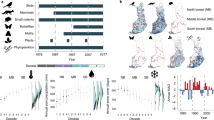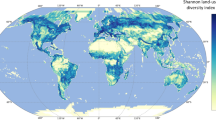Abstract
One hypothesis for the latitudinal gradient in species richness observed in most animal taxa is that the richness of a region is determined by its geographic area. However, the relationship between geographic area and species richness across regions is generally weak. It has been suggested that this is because species from the tropics spill out of this region of high richness, artificially inflating the richness of other regions. This generates the interesting prediction that the area and richness of extra-tropical regions should be more strongly correlated if tropical species are excluded. We test this prediction using the avifauna of the New World. We find that there is indeed a relationship between the land area and species richness of a region once tropical species are excluded. This relationship is independent of the latitude and productivity of regions. Both latitude and productivity can explain variance in richness unexplained by land area. There is no relationship between land area and species richness if tropical species are not excluded from the analysis, suggesting that tropical species do indeed mask the relationship between richness and area. We conclude that our results generally support the geographic area hypothesis, although tests of its other predictions and on other land masses are required.
Similar content being viewed by others
References
Adams, J.M. and Woodward, F.I. (1989) Patterns in tree species richness as a test of the glacial extinction hypothesis. Nature 339, 699–701.
Begon, M., Harper, J.L. and Townsend, C.R. (1990) Ecology: Individuals, Populations and Communities. Blackwell, Oxford.
Blackburn, T.M. and Gaston, K.J. (1996a) Spatial patterns in the species richness of birds in the New World. Ecography 19, 369–376.
Blackburn, T.M. and Gaston, K.J. (1996b) Spatial patterns in the geographic range sizes of bird species in the New World. Phil. Trans. R. Soc., B 351, 897–912.
Blackburn, T.M. and Gaston, K.J. (1996c) The distribution of bird species in the New World: Patterns in species turnover. Oikos 77, 146–152.
Blackburn, T.M. and Gaston, K.J. (in press) Spatial patterns in the body sizes of bird species in the New World. Oikos.
Brown, J.H. (1988) Species diversity. In Analytical Biogeography: An Integrated Approach to the Study of Animal and Plant Species Diversity (A.A. Myers and P.S. Giller, eds.), pp. 57–89. Chapman and Hall, London.
Brown, J.W. and Opler, P.A. (1990) Patterns of butterfly species richness in peninsular Florida. J. Biogeog. 17, 615–622.
Colwell, R.K. and Hurtt, G.C. (1994) Nonbiological gradients in species richness and a spurious Rapoport effect. Am. Nat. 144, 570–595.
Fischer, A.G. (1960) Latitudinal variations in organic diversity. Evolution 14, 64–81.
Gaston, K.J. (1993) Spatial patterns in the description and richness of the Hymenoptera. In Hymenoptera and Biodiversity (J. LaSalle and I.D. Gauld, eds), pp. 277–293. C.A.B. International Press, Wallingford.
Gaston, K.J. and Blackburn, T.M. (1995) Mapping biodiversity using surrogates for species richness: Macroscales and New World birds. Proc. R. Soc., B 262, 335–341.
Gaston, K.J. and Blackburn, T.M. (1996a) The tropics as a museum of biological diversity: An analysis of the New World avifauna. Proc. R. Soc., B 263, 63–68.
Gaston, K.J. and Blackburn, T.M. (1996b) The spatial distribution of threatened species: Macro-scales and New World birds. Proc. R. Soc., B 263, 235–240.
Gaston, K.J. and Williams, P.H. (1996) Spatial patterns in taxonomic diversity. In Biodiversity: A Biology of Numbers and Difference (K.J. Gaston, ed.), pp. 202–229. Blackwell, Oxford.
Jablonski, D. (1993) The tropics as a source of evolutionary novelty through geological time. Nature 364, 142–144.
Janzen, D.H. (1981) The peak of North American Ichneumonid species richness lies between 38° and 42°N. Ecology 62, 532–537.
Järvinen, O. (1979) Geographical gradients of stability in European land bird communities. Oecologia 38, 51–69.
Latham, R.E. and Ricklefs, R.E. (1993) Global patterns of tree species richness in moist forests: Energy-diversity theory does not account for variation in species richness. Oikos 67, 325–333.
MacArthur, R.H. (1969) Patterns of communities in the tropics. Biol. J. Linn. Soc. 1, 19–30.
MacArthur, R.H. (1972) Geographical Ecology: Patterns in the Distribution of Species. Harper and Row, New York.
MacArthur, R.H. and MacArthur, J.W. (1961) On bird species diversity. Ecology 42, 594–598.
Owen, D.F. and Owen, J. (1974) Species diversity in temperate and tropical Ichneumonidae. Nature 249, 583–584.
Pagel, M.D., May, R.M. and Collie, A.R. (1991) Ecological aspects of the geographical distribution and diversity of mammalian species. Am. Nat. 137, 791–815.
Pianka, E.R. (1966) Latitudinal gradients in species diversity: A review of the concepts. Am. Nat. 100, 33–46.
Platnick, N.I. (1992) Patterns of biodiversity. In Systematics, Ecology and the Biodiversity Crisis (N. Eldredge, ed.), pp. 15–24. Columbia University Press, New York.
Ricklefs, R.E. (1979) Ecology. Chiron, New York.
Ricklefs, R.E. and Schluter, D. (eds) (1993) Species Diversity in Ecological Communities. University of Chicago Press, Chicago, IL.
Rohde, K. (1992) Latitudinal gradients in species diversity: The search for the primary cause. Oikos 65, 514–527.
Rosenzweig, M.L. (1992) Species diversity gradients: We know more and less than we thought. J. Mammal. 73, 715–730.
Rosenzweig, M.L. (1995) Species Diversity in Space and Time. Cambridge University Press, Cambridge.
Shmida, A. and Wilson, M.V. (1985) Biological determinants of species diversity. J. Biogeogr. 12, 1–20.
Smith, F.D.M., May, R.M. and Harvey, P.H. (1994) Geographical ranges of Australian mammals. J. Anim. Ecol. 63, 441–450.
Stevens, G.C. (1989) The latitudinal gradient in geographical range: How so many species co-exist in the tropics. Am. Nat. 133, 240–256.
Terborgh, J. (1973) On the notion of favourableness in plant ecology. Am. Nat. 107, 481–501.
Uchijima, Z. and Seino, H. (1987) Maps of Net Primary Productivity of Natural Vegetation and Related Climatic Elements on Continents. National Institute of Agro-Environmental Sciences, Kyushu National Agricultural Experiment Station, Kyushu.
Williams, P.H. (1992) WORLDMAP Priority Areas for Biodiversity, Version 3. Privately distributed computer software and manual, London.
Williams, P.H. (1993) Measuring more of biodiversity for choosing conservation areas, using taxonomic relatedness. In International Symposium on Biodiversity and Conservation (T.-Y. Moon, ed.), pp. 194–227. Korean Entomological Institute, Seoul.
Wright, D.H., Currie, D.J. and Maurer, B.A. (1993) Energy supply and patterns of species richness on local and regional scales. In Species Diversity in Ecological Communities (R.E. Ricklefs and D. Schluter, eds), pp. 66–74. Chicago University Press, Chicago, IL.
Author information
Authors and Affiliations
Rights and permissions
About this article
Cite this article
Blackburn, T.M., Gaston, K.J. The relationship between geographic area and the latitudinal gradient in species richness in New World birds. Evolutionary Ecology 11, 195–204 (1997). https://doi.org/10.1023/A:1018451916734
Issue Date:
DOI: https://doi.org/10.1023/A:1018451916734




